




Influenza (flu) viruses share a similar genetic makeup, and they all infect the respiratory system. But there are several types and subtypes, some of which are more of a threat than others. Mainly there are four types of flu viruses, called A, B, C, and D, some of which can be further categorized into subtypes or at least specific strains.

Influenza A viruses can be found in many different animals, including birds and mammals, as well as humans. These viruses are further separated into subtypes by number. The subtypes are classified by the specific combination of two proteins that are attached to them:
There are 18 different H subtypes and 11 different N subtypes, and 131 subtype combinations have been detected in nature. Examples of flu viruses in this category include H1N1 (Swine Flu) and H3N2.
|
This is a picture of an influenza virus. Influenza A viruses are classified by subtypes based on the properties of their hemagglutinin (H) and neuraminidase (N) surface proteins. There are 18 different HA subtypes and 11 different NA subtypes. Subtypes are named by combining the H and N numbers – e.g., A(H1N1), A(H3N2). |
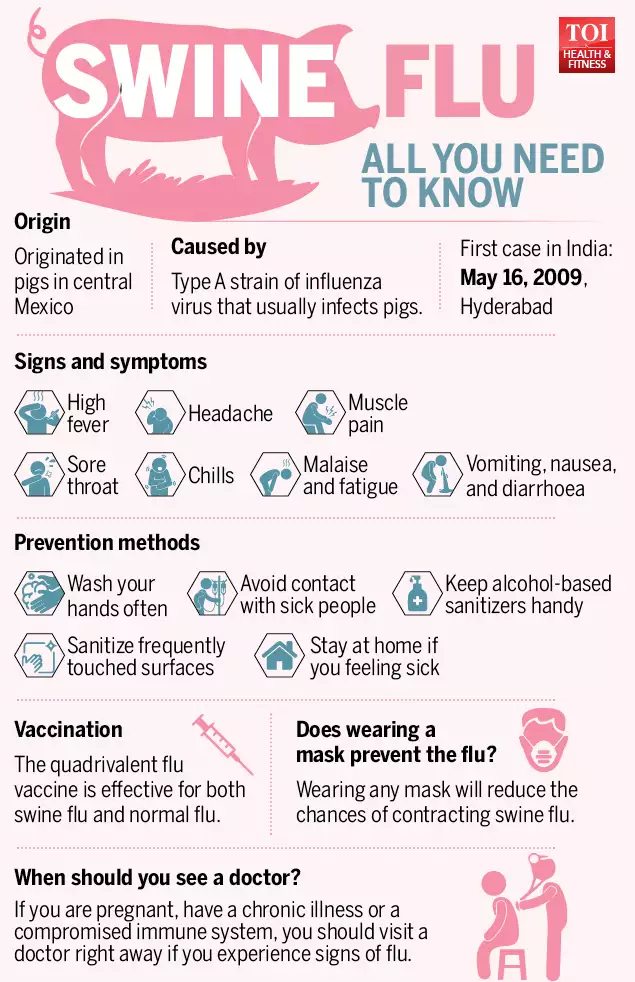
H3N2Influenza A virus subtype H3N2 (A/H3N2) is a subtype of viruses that causes influenza (flu). H3N2 viruses can infect birds and mammals. In birds, humans, and pigs, the virus has mutated into many strains. Symptoms of H3N2 Symptoms typically appear suddenly and can include: Cough, runny or congested nose, sore throat, headache, body aches and pains, fever, chills, fatigue, diarrhea, vomiting Vaccine for H3N2 According to the CDC, the flu vaccine reduces the risk of flu illness in the general population by between 40 and 60 percent during most flu seasons when the vaccine strains are a good match to circulating strains. The flu vaccine tends to offer more protection from flu that’s caused by H1N1 viruses and influenza B viruses in comparison to H3N2 viruses. Treatment of H3N2 Treatment of an uncomplicated case of seasonal flu, such as H3N2, involves managing symptoms while you recover. Ways to do this include: getting plenty of rest, drinking enough fluids, taking over-the-counter medication to relieve symptoms such as fever, headache, and aches and pains Some people are at an increased risk of developing serious complications from the flu. These complications can include pneumonia or worsening of a preexisting medical condition, such as asthma. |
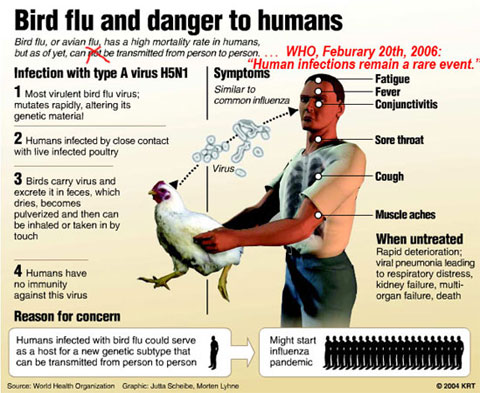
Bird flu or Avian Influenza (A1) is a contagious disease of bird raging from mild to serve form of illness. Some forms of bird flu infections can cause illness to humans.
Bird flu is caused by influenza A virus. There are three main subtypes of avian flu, including H5, H7, and H9. The subtypes H5 and H7 are the most deadly, while the H9 subtype is less dangerous.
The outbreaks affecting some Asian countries have been caused by influenza A/H5N1 virus. It can also cause severe infection in humans. Typically, it's transmitted between birds, but it can be passed from bird to human. It does not appear to spread from person to person.
History
First identified in Italy in 1878, highly pathogenic avian influenza is characterized by sudden onset of severe disease, rapid contagion, and a mortality rate that can approach 100% within 48 hours.
Human deaths from avian influenza were unknown until 1997, when six people in Hong Kong died from the particularly virulent H5N1 strain.
Etiologic Agent
The causative agent is the avian influenza (A1) virus. A1 viruses all belong to the influenza virus, a genus of the Orthomyxoviridae family and are negative-stranded, and segmented.
Modes of Transmission
Avian influenza spreads in the air and in manure. Wild fowl often acts as resistant carrier spreading it to more susceptible domestic stocks.
It can also be transmitted through contaminated feeds, water, equipment, and clothing.
Cats are also thought to be possible infection vectors for H5N1 strains of avian flu.
While avian influenza spreads rapidly among birds, it does not infect humans easily, and there is no confirmed evidence of human-to-human transmission. Of the 15 subtypes known, only subtypes H5 and H7 are known to be capable of crossing the species barrier.
Is it safe to eat chicken, poultry products and other wild game birds?
Yes, it is safe to eat properly prepared and cooked poultry and game birds. The virus is sensitive to heat. Normal temperatures used for cooking (so that food reaches 70°C in all parts) will kill the virus.
Incubation Period
The incubation period is three to five days.
Signs and Symptoms
The symptoms of H5N1 infection may include fever (often high fever, > 38°C) and malaise, cough, sore throat, and muscle aches. Other early symptoms may include abdominal pain, chest pain and diarrhoea. The infection may progress quickly to severe respiratory illness (for example, difficulty breathing or shortness of breath, pneumonia, Acute Respiratory Distress Syndrome) and neurologic changes (altered mental status or seizures).
Treatment
The antiviral medicine oseltamivir can reduce the severity of illness and prevent death, and should be used in all cases.
Candidate vaccines to prevent H5N1 infection have been developed, but they are not ready for widespread use.
These viruses only affect people and are characterized according to where the virus was originally isolated. The two main categories (lineages) of influenza B include B/Yamagata and B/Victoria.
So, for example, you may hear about an influenza B (Victoria) or B (Yamagata) virus.
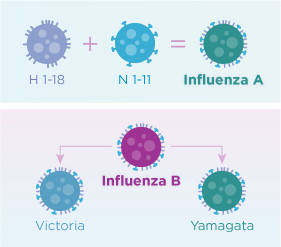
This type of flu can affect people, but most often only causes mild illness. Influenza C infections are not thought to cause human flu epidemics, which are defined as widespread flu illness in a localized area.
This type of flu primarily affects cattle and is not known to affect people.
What Types of Flu Do Vaccines Prevent?
Flu vaccines are customized each year to protect against the strains researchers believe are most likely to circulate among humans that season. Every year, the vaccine contains:8
The vaccine only protects you from the specific strains it contains. It doesn't contain C or D viruses, and it doesn't protect against other viral illnesses with similar symptoms, which often spread during flu season.
CDC follows an internationally accepted naming convention for influenza viruses. This convention was accepted by WHO in 1979 and published in February 1980 in the Bulletin of the World Health Organization. The approach uses the following components:
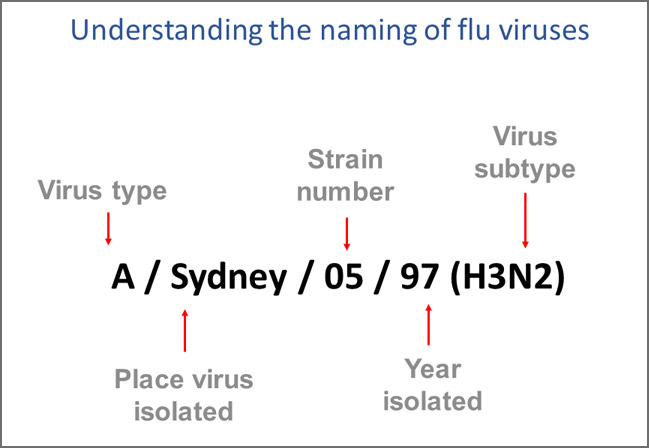
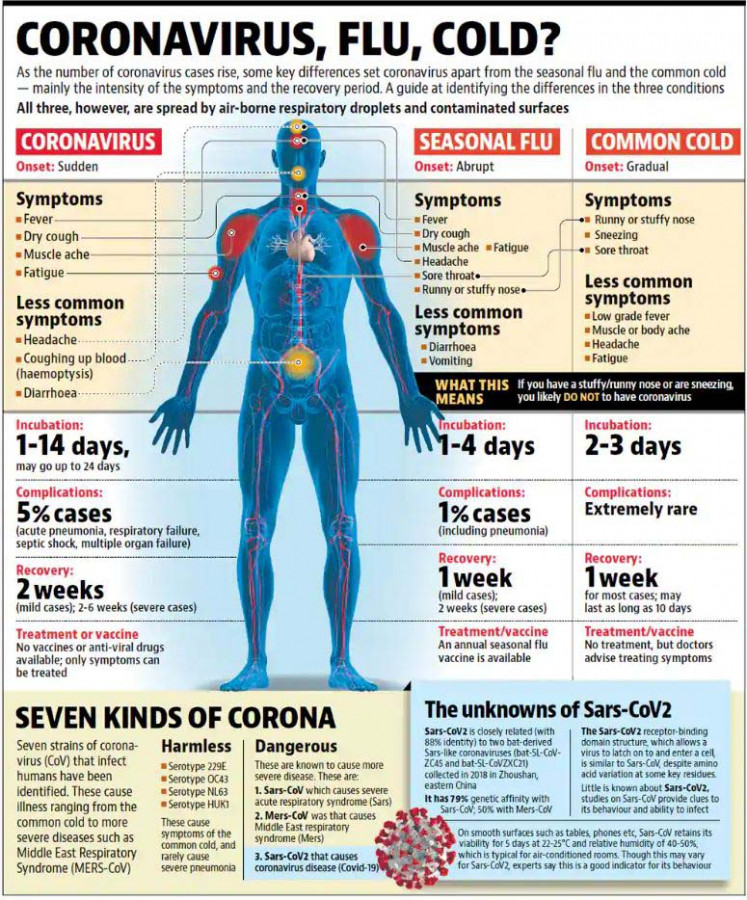
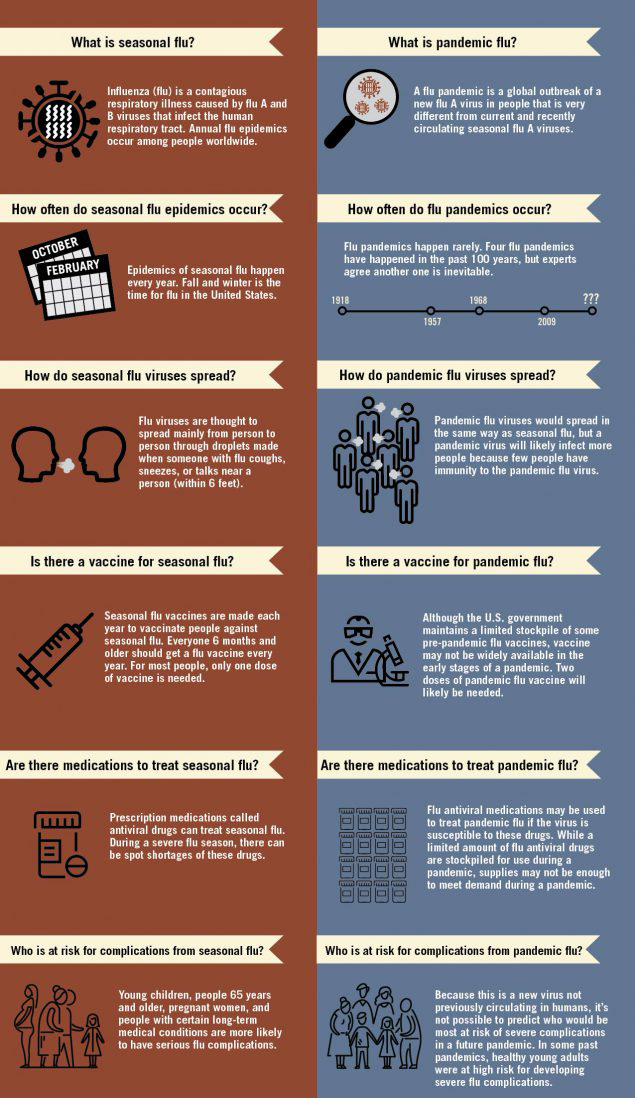
Antigenic 'shift' occurs in HA and NA antigens and is associated with pandemics.
The genetic change that enables a flu strain to jump from one animal species to another, including humans, is called antigenic shift. Antigenic shift can happen in three ways:
Antigenic Shift 1
Antigenic Shift 2
Antigenic Shift 3
The new strain may further evolve to spread from person to person. If so, a flu pandemic could arise.
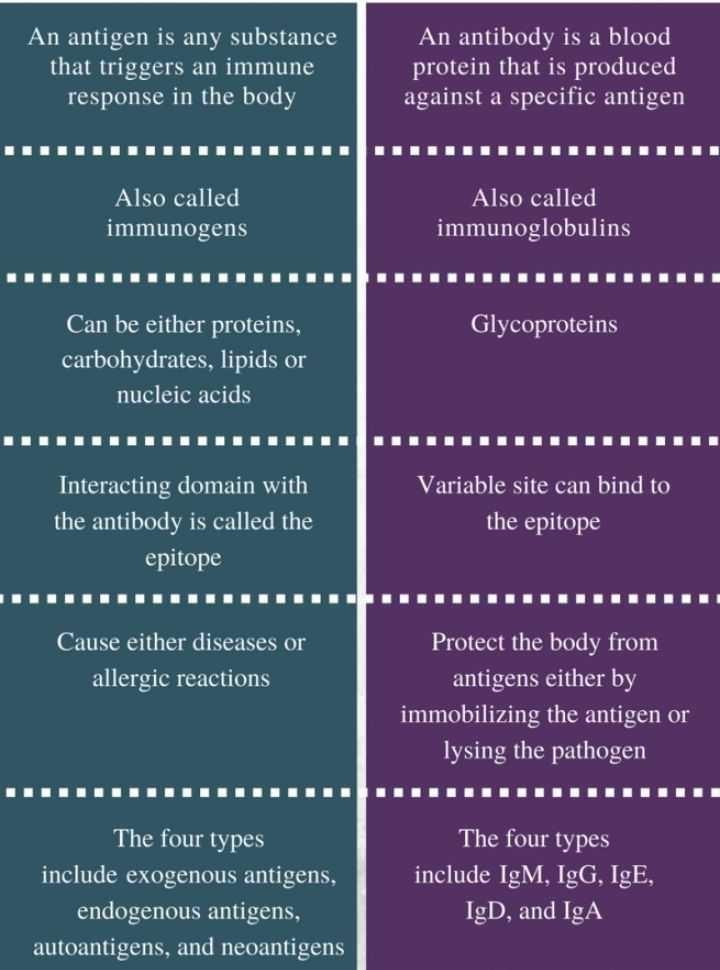
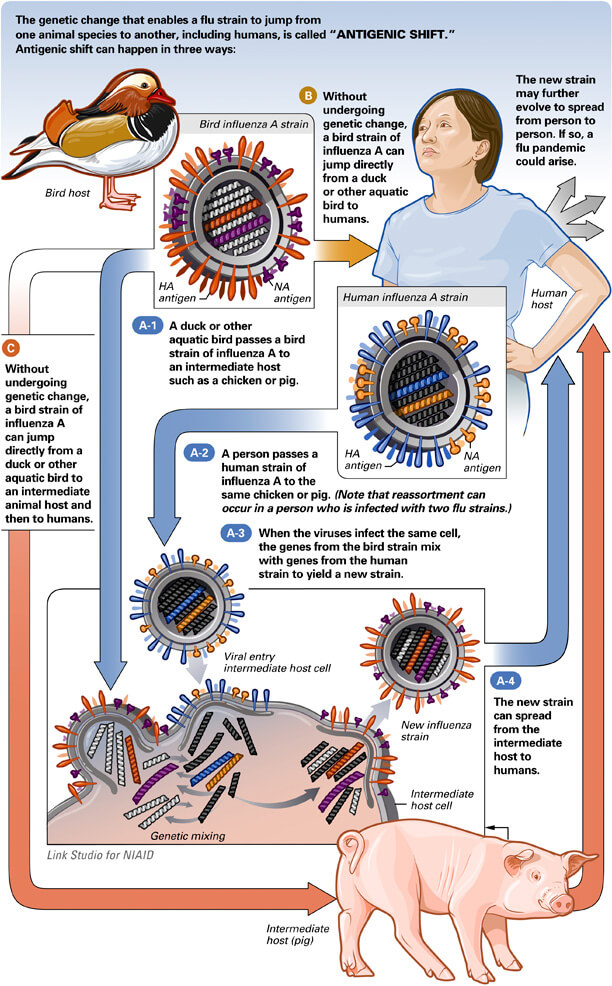
Antigenic 'drift' occurs in HA and NA, and is associated with seasonal epidemics.
Each year's flu vaccine contains three flu strains -- two A strains and one B strain -- that can change from year to year.
If the HA antigen changes shape, antibodies that normally would match up to it no longer can, allowing the newly mutated virus to infect the body's cells. This type of genetic mutation is called "antigenic drift."
|
A mutation is a change in a DNA sequence. Mutations can result from DNA copying mistakes made during cell division, exposure to ionizing radiation, exposure to chemicals called mutagens, or infection by viruses. |
Influenza viruses can change through antigenic drift. Drift is a continuous ongoing process that results in the emergence of new strain variants. The amount of change can be subtle or dramatic, but eventually one of the new variant strains becomes dominant, usually for a few years, until a new variant emerges and replaces it. In essence, drift affects the influenza viruses that are already in worldwide circulation. This process allows influenza viruses to change and re-infect people repeatedly through their lifetime and is the reason the influenza virus strains in vaccine must be updated each year.
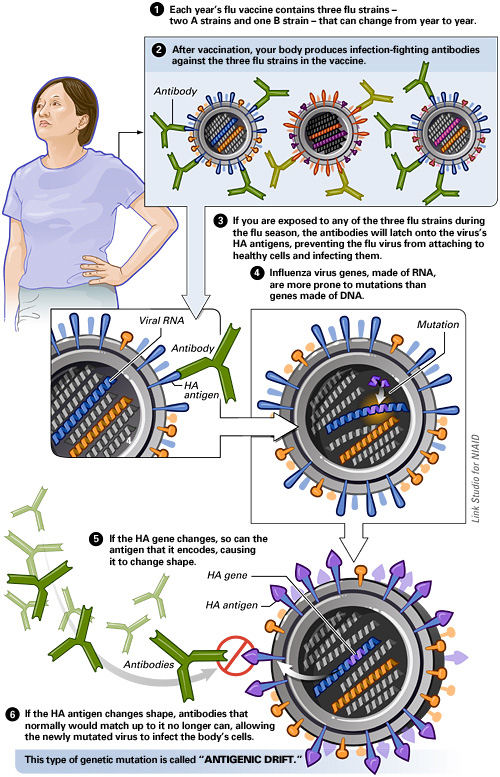
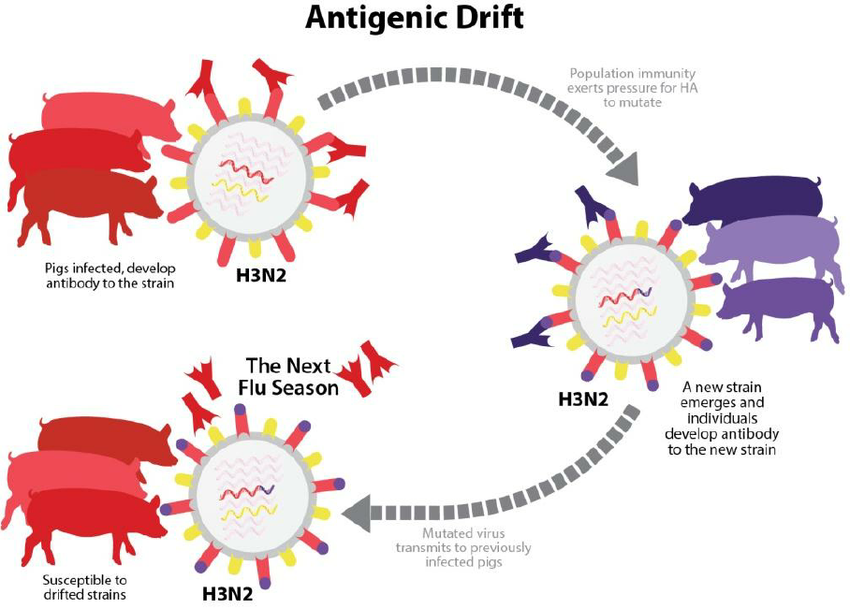
In contrast to drift, pandemic viruses arise through a process known as antigenic shift. In this process, the surface existing viral H and N proteins are not modified, but are replaced by significantly different H and Ns. Since influenza A viruses that bear new (or novel) H or H/N combinations are perceived by immune systems as new, most people do not have pre-existing antibody protection to these novel viruses. This is one of the reasons that pandemic viruses can have such severe impact on the health of populations.
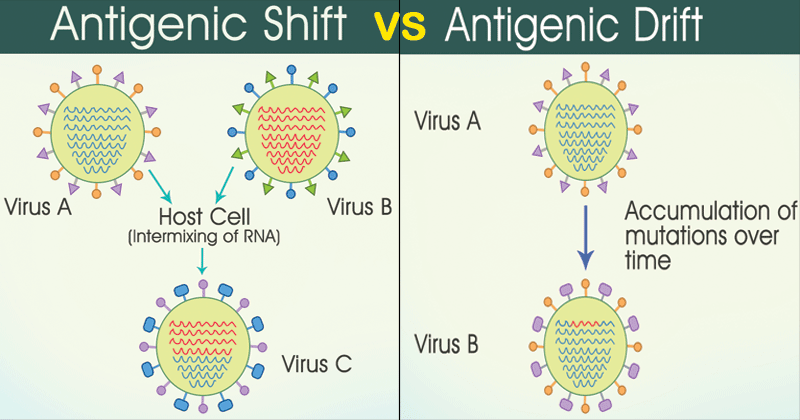
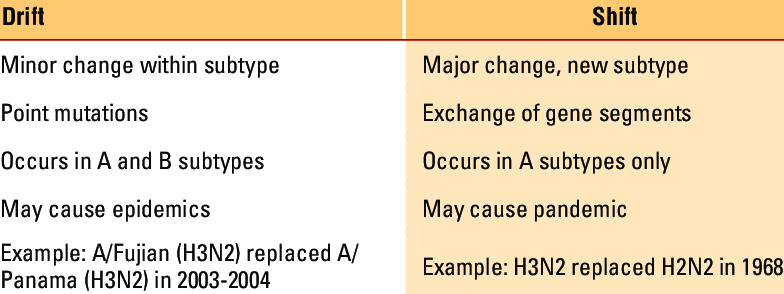
© 2025 iasgyan. All right reserved